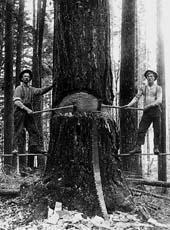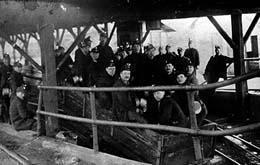By Sharon Boswell
and Lorraine McConaghy,
Special to The Times
 Proud Seattleites, left, thronged the docks at Moran shipyards
to cheer the 1904 launching of
the battleship Nebraska. The Seattle Times had led a front-page campaign
to help bring this major contract to the city and boost the local economy.
Moran Shipyards was a frequent advertiser in The Times, touting its
new drydock, machine shop and other industrial services. Photo Credit: Museum of History and Industry.
Proud Seattleites, left, thronged the docks at Moran shipyards
to cheer the 1904 launching of
the battleship Nebraska. The Seattle Times had led a front-page campaign
to help bring this major contract to the city and boost the local economy.
Moran Shipyards was a frequent advertiser in The Times, touting its
new drydock, machine shop and other industrial services. Photo Credit: Museum of History and Industry.
WHEN THE GOLD RUSH HIT IN 1897, SEATTLE'S PACE BECAME FRANTIC.
Prospectors and sightseers thronged the docks and sidewalks, and hucksters
grabbed innocents to sell them the best map, a sure thing or a good time.
The instant city ran full throttle, racing to squeeze every penny out of the boom.
The great rush to the Klondike gold fields continued into the 20th century as adventurers
chased new excitements throughout Alaska and western Canada. Nearly every miner made Seattle his
last stop before the Yukon and his first stop afterward. Entrepreneurs -- selling everything from whiskey
to cure-alls to Beacon Hill cottages -- settled in for the long haul.
But the city hoped to be more than a boomtown tied to the fortunes of distant gold strikes.
The Times' annual business reviews celebrated Seattle as Queen City of the Pacific and the metropolis of
Washington state. The city was emerging as a major crossroads, where the rich resources from Northwest
farms and ranches, mines, waters and woods poured in, were processed -- logs to lumber, pigs to bacon,
fleece to blankets -- and exported.
 Two loggers, left, stand on springboards, posing with the tools of their trade. Photo Credit: Seattle Times.
Two loggers, left, stand on springboards, posing with the tools of their trade. Photo Credit: Seattle Times.
MOST BOOSTERS, INCLUDING THE TIMES, COURTED EASTERN FINANCIERS to invest in the development
of Seattle and Washington state. However, the newspaper also encouraged local investment
in the "gold field" of Bellingham and Spokane, the quartz mines at Index and the oil sands
of Des Moines, as well as new foundries, machine shops and factories.
After the bonanza, Seattle's banks, bulging with gold, searched for borrowers.
No longer just a marketplace, the city moved beyond resource-based industries to
sophisticated manufacturing.
When the Gold Rush began, Robert Moran's little Seattle shipyard built
a dozen wooden steamers to ferry passengers and freight along the Yukon River.
Only four years later, the shipyard borrowed nearly $500,000 from local banks
to construct one of the finest drydocks on the West Coast.
When the shipyard bid high to build the great battleship Nebraska,
The Times raised more than $100,000 to help Moran lower his proposal
and win the contract. At least 500 craftsmen had work for two years while Moran
Shipyards, Vulcan Iron Works and other factories helped transform Seattle
from a boomtown to a metropolis.
 Right, a crew of miners prepares to go down into the Newcastle coal slope. Before 1900,
most of King County's wageworkers depended on extractive industries such as logging and mining
to make a living. Photo Credit: Seattle Times.
Right, a crew of miners prepares to go down into the Newcastle coal slope. Before 1900,
most of King County's wageworkers depended on extractive industries such as logging and mining
to make a living. Photo Credit: Seattle Times.
THE CITY'S LAND VALUES SKYROCKETED AS DEVELOPERS built homes
in the new working-class and middle-class suburban districts, perched rows of elegant homes
atop First Hill, and expanded downtown with offices and stores.
Shops like Schoenfeld's Standard Furniture, Wa Chong Importers, the Bon Marché,
Frederick and Nelson, and Sherman Clay advertised in the newspapers. Local developers bought
display ads to encourage readers to buy land, to invest, to get rich; classified ads directed them
to better jobs and new houses. The Times' circulation increased 500 percent in the first four years
of the Gold Rush as the newspaper grew up with the city.
In 1899, more than $100 million passed through Seattle's banks, and by 1900, the city's
bank transactions were greater than those in Los Angeles.
At the turn of the century, news of an Alaska steamship's arrival carrying $750,000
in gold was old hat. Flush and ambitious, Seattle was proud of a solid prosperity that
no longer depended entirely on the Klondike.
As it grew more sophisticated, the city became more conscious of its problems:
the smelly tideflats, unplanked roads, and hills that seemed to block growth.
Vice and crime reigned in the Tenderloin, its red-light district. Every evening's paper
described another knifing, another robbery.
And as the 20th century opened, those who hadn't shared in the city's new wealth were pushed
to the margins of society, considered unlucky or undeserving. Amid plenty, distinctions
of class and race hardened in Seattle.
Historians Sharon Boswell and Lorraine McConaghy teach at local universities and do research,
writing and oral history. Original newspaper graphics courtesy of Seattle Public Library.